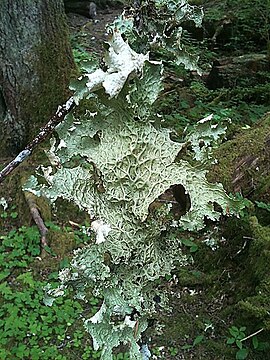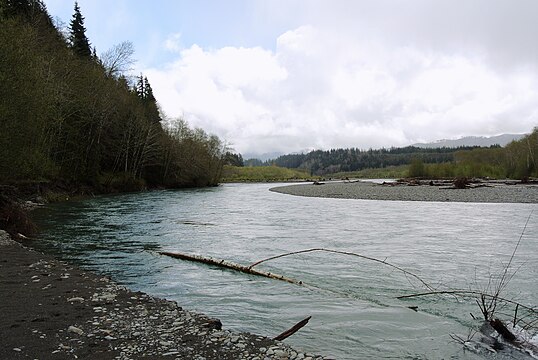
Hoh Rainforest is one of the largest temperate rainforests in the U.S., located on the Olympic Peninsula in western Washington state. It encompasses 24 square miles (62 km) of low elevation forest along the Hoh River, ranging from 394 to 2,493 feet (120 to 760 m). The rainforest receives an average of 140 inches (360 cm) of annual precipitation—among the rainiest places in the United States. The Hoh River valley was formed thousands of years ago by glaciers and is the ancestral home of the Hoh people.
Within Olympic National Park, the forest is protected from commercial exploitation. Between the park boundary and the Pacific Ocean, 48 km (30 mi) of river, much of the forest has been logged within the last century, although many pockets of forest remain. The protected portion of the forest includes the "One Square Inch of Silence", a 1-square-inch (6.5 cm) monument to mark what it deems the "quietest place in the United States". It was placed in 2005 as part of a demonstration in favor of noise control.
Climate
Hoh Rainforest is the wettest forest in the Contiguous United States, receiving 129 inches (3,300 mm) of rain per year. It is an Oceanic climate (Köppen climate classification: Cfb), with a much higher rainfall during the winter.
| Climate data for Hoh Ranger Station, Olympic National Park, Washington | |||||||||||||
|---|---|---|---|---|---|---|---|---|---|---|---|---|---|
| Month | Jan | Feb | Mar | Apr | May | Jun | Jul | Aug | Sep | Oct | Nov | Dec | Year |
| Record high °F (°C) | 54 (12) |
62 (17) |
69 (21) |
86 (30) |
87 (31) |
93 (34) |
94 (34) |
93 (34) |
88 (31) |
71 (22) |
58 (14) |
53 (12) |
94 (34) |
| Mean daily maximum °F (°C) | 40.8 (4.9) |
44.3 (6.8) |
47.1 (8.4) |
54.8 (12.7) |
61.1 (16.2) |
63.9 (17.7) |
71.6 (22.0) |
71.5 (21.9) |
66.6 (19.2) |
55.2 (12.9) |
46.3 (7.9) |
40.2 (4.6) |
55.3 (12.9) |
| Mean daily minimum °F (°C) | 33.5 (0.8) |
33.0 (0.6) |
34.0 (1.1) |
37.1 (2.8) |
42.6 (5.9) |
47.4 (8.6) |
50.7 (10.4) |
51.2 (10.7) |
47.4 (8.6) |
41.2 (5.1) |
36.0 (2.2) |
32.7 (0.4) |
40.6 (4.8) |
| Record low °F (°C) | 12 (−11) |
20 (−7) |
23 (−5) |
28 (−2) |
26 (−3) |
31 (−1) |
39 (4) |
38 (3) |
37 (3) |
27 (−3) |
18 (−8) |
17 (−8) |
12 (−11) |
| Average precipitation inches (mm) | 24.86 (631) |
11.70 (297) |
14.45 (367) |
10.27 (261) |
6.30 (160) |
3.72 (94) |
2.60 (66) |
3.67 (93) |
7.07 (180) |
10.12 (257) |
20.88 (530) |
14.27 (362) |
129.91 (3,298) |
| Average snowfall inches (cm) | 7.7 (20) |
7.6 (19) |
2.7 (6.9) |
0.7 (1.8) |
0.0 (0.0) |
0.0 (0.0) |
0.0 (0.0) |
0.0 (0.0) |
0.0 (0.0) |
0.0 (0.0) |
2.3 (5.8) |
6.5 (17) |
27.5 (70.5) |
| Source: | |||||||||||||
| Hoh Rainforest, Washington (U.S. State) | ||||||||||||||||||||||||||||||||||||||||||||||||||||||||||||
|---|---|---|---|---|---|---|---|---|---|---|---|---|---|---|---|---|---|---|---|---|---|---|---|---|---|---|---|---|---|---|---|---|---|---|---|---|---|---|---|---|---|---|---|---|---|---|---|---|---|---|---|---|---|---|---|---|---|---|---|---|
| Climate chart (explanation) | ||||||||||||||||||||||||||||||||||||||||||||||||||||||||||||
| ||||||||||||||||||||||||||||||||||||||||||||||||||||||||||||
Flora

The dominant species in the rainforest are Sitka spruce (Picea sitchensis) and western hemlock (Tsuga heterophylla); some grow to tremendous size, reaching over 300 feet (91 m) in height and 23 ft (7.0 m) in diameter. Coast Douglas-fir (Pseudotsuga menziesii var. menziesii), western red cedar (Thuja plicata), bigleaf maple (Acer macrophyllum), red alder (Alnus rubra), vine maple (Acer circinatum), and black cottonwood (Populus trichocarpa) are also found throughout the forest.
Many unique mosses and lichens are also present in the rainforest, such as lettuce lichen (Lobaria oregana), which "requires the cool, moist conditions found under the canopy of old-growth forests" and is consumed by deer, elk, and other animals.
Fauna
Much native fauna also makes the Hoh Rainforest their home, including the Pacific tree frog (Pseudacris regilla), northern spotted owl (Strix occidentalis caurina), bobcat (Lynx rufus), cougar (Puma concolor cougar), raccoon (Procyon lotor), Olympic black bear (Ursus americanus altifrontalis), Roosevelt elk (Cervus canadensis roosevelti), coyote (Canis latrans), Cascade red fox (Vulpes vulpes), and black-tailed deer (Odocoileus columbianus). Recently, naturalists have been planning on reintroducing fishers to the forest and surrounding forests due to their almost extirpated population in Washington and the introduced Virginia opossum is beginning to make way to the region in and around the forest.
The area is also home to the banana slug (Ariolimax columbianus), which has recently been threatened by the encroachment of a new species of slug, the black slug (Arion ater), an invasive species from Northern Europe.
Trails
The Hoh Rainforest is home to a National Park Service ranger station, from which backcountry trails extend deeper into the national park.
Near the visitor center is the Hall of Mosses Trail, a short trail—0.8 miles (1.3 km)— which gives visitors a feel for the local ecosystem and views of maples draped with large growths of spikemoss. There is also the Spruce Nature Trail (1.2 miles (1.9 km)), which includes signs that identify various trailside trees and plants.
Gallery
- See also
 Media related to Hoh Rainforest at Wikimedia Commons
Media related to Hoh Rainforest at Wikimedia Commons
-
 Lobaria oregana on the forest floor
Lobaria oregana on the forest floor
-
 National Park Service sign at the entrance of the park
National Park Service sign at the entrance of the park
-
 The Hoh River that runs through the forest
The Hoh River that runs through the forest
-
A herd of elk grazing at the forest
-
 A banana slug
A banana slug
-
A nurse log providing nutrients for other growing trees
References
- ^ "Visiting the Hoh Rain Forest". National Park Service. Retrieved November 27, 2024.
- Mapes, Lynda V. (February 2, 2010). "Hoh Rain Forest revels in wet, 'wild ballet'". The Seattle Times. Retrieved November 27, 2024.
- Patel, Samir S. (August 10, 2018). "Are You Listening? Hear What Uninterrupted Silence Sounds Like". All Things Considered. NPR. Retrieved November 27, 2024.
- "HOH RS, WASHINGTON (453710)". Western Regional Climate Center. Archived from the original on February 13, 2017. Retrieved May 2, 2018.
- McCarty, Laura P. (May–June 1992). "America's Rainforests" (PDF). National Parks. Vol. 66, no. 5–6. National Parks Conservation Association. pp. 46–48. ISSN 0276-8186. OCLC 1245780644. Retrieved November 27, 2024.
- Bolen, E.G. (1998). Ecology of North America. John Wiley & Sons. p. 346. ISBN 0-471-13156-3.
- Cowie R. H., Dillon R. T., Robinson D. G. & Smith J. W. (2009). "Alien non-marine snails and slugs of priority quarantine importance in the United States: A preliminary risk assessment". American Malacological Bulletin 27: 113–132. PDF.
External links
- Visiting the Hoh Rain Forest at the National Park Service
- Temperate Rain Forest at the National Park Service
- The Hoh River Trust Archived 2016-10-15 at the Wayback Machine, founded by the Wild Salmon Center and the Western Rivers Conservancy
47°51′41.2″N 123°55′28.8″W / 47.861444°N 123.924667°W / 47.861444; -123.924667
Categories: